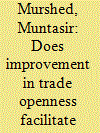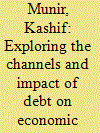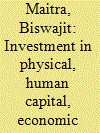|
|
|
Sort Order |
|
|
|
Items / Page
|
|
|
|
|
|
|
| Srl | Item |
| 1 |
ID:
161488


|
|
|
|
|
| Summary/Abstract |
The study examines factors influencing non-performing loans (NPLs) for Indian banks. The analysis contributes by including restructured advances also in addition to standard measures of asset quality that provides comprehensive picture of pressure on banks’ balance sheet. Moreover, Bayesian technique with multivariate t-distributed prior is applied for robust estimation. Utilizing quarterly dataset from 2005 to 2015, strong persistence of bad assets is clearly evident. Bank-specific characteristics such as growth of advances, profitability and net interest margin are significant determinants. Among macro-factors, high growth rate is having retarding impact on bad assets. Moreover, ownership effect is having differential behaviour with state-owned banks being most vulnerable.
|
|
|
|
|
|
|
|
|
|
|
|
|
|
|
|
| 2 |
ID:
161485


|
|
|
|
|
| Summary/Abstract |
The aim of this article is to empirically shed light on the impacts of trade openness (TO) on facilitation of renewable energy transition (RET) across Bangladesh, India, Pakistan, Sri Lanka and Nepal. Against this backdrop, this article incorporated annual time series data stemming from 2000 to 2017 and employed the two-stage least squares (2SLS) panel data estimation methodology. In addition, the panel Granger causality test was also applied to distinguish the possible long-run causal associations between the variables considered in the regression models. In the light of the estimated results, it is found that an improvement in TO triggers renewable energy consumption, improves the primary energy-use efficiency and elevates the access to clean cooking fuel technology within the selected South Asian economies. However, the results also led to the concerning conclusion regarding the ineffectiveness of the trade liberalization policies in curbing the relative consumption of non-renewable energy resources, thereby marginalizing the prospects of overall RET within these economies.
|
|
|
|
|
|
|
|
|
|
|
|
|
|
|
|
| 3 |
ID:
161486


|
|
|
|
|
| Summary/Abstract |
The objective of this study is to analyse the effect of debt on economic growth as well as the channels, that is, investment, total factor productivity (TFP), interest rate and saving channel through which debt affects economic growth in South Asian countries. The study uses growth model based on conditional convergence and augments to include debt. Panel data of four South Asian countries from 1990 to 2013 at annual frequency are utilized and fixed effect model is used for estimation. The results of the study showed that inverted U-shaped relationship exists between debt and economic growth in South Asian countries. However, the most important and significant channel through which debt affects economic growth is private and public investment as well as TFP. Reducing debt accumulation alone will not rectify the problem unless the supplementary macroeconomic policies are made sound; therefore, there is a dire need to improve macroeconomic policies, good governance and elimination of structural distortions.
|
|
|
|
|
|
|
|
|
|
|
|
|
|
|
|
| 4 |
ID:
161490


|
|
|
|
|
| Summary/Abstract |
This article studies the efficacy of the public investment in human capital and physical capital to raise income in Bangladesh over the period 1980–2016. This article also assesses whether the investment in human capital and income have raised life expectancy of the country. The Johansen cointegration test identifies a long-run relation of income with investment on education, health care and physical capital. The error correction mechanism (ECM) based on the cointegrating relation followed by the Wald test of Granger causality has found that these investments have caused income to rise with some lag periods. Robustness of these findings is confirmed by involving an autoregressive distributed lag (ARDL) model of cointegration followed by its ECM representation. On the other hand, the Johansen and ARDL methods of cointegration followed by their ECMs have also found a long-run relation of life expectancy with the investment in education, health care and income. A decisive role of the investment in health care and income on life expectancy is observed, while an unusual negative role of the investment in education is also found. However, positive value of the long-run coefficients of the education and health-care investments of the ECM-ARDL model indicate some long-run favourable impact of these investments on life expectancy in Bangladesh.
|
|
|
|
|
|
|
|
|
|
|
|
|
|
|
|
| 5 |
ID:
161487


|
|
|
|
|
| Summary/Abstract |
The article studies the impact of outsourcing services on the productivity growth of the Indian manufacturing firms. By the term services we mean different expenses on services incurred by the manufacturing firms, such as, advertising, marketing, research and development, consultancy, auditing, business services, knowledge-based services, technical, legal and other professional services (including information communication and technology services). With further expansion in newer services, a higher demand has come from the Indian manufacturing sector. With intensive usage of services in the manufacturing production process, the performance and the manufacturing can focus on the core competencies with outsourced and cheaper services from expert service provider. For this purpose, the firm-level data have been collected from the annual financial statements of the Centre for Monitoring of the Indian Economy’s Prowess database. The econometric results conclude that services have played a positive role in improving the productivity growth of the aggregate Indian manufacturing firms and at the disaggregated level, especially for industrial groups such as food, beverage and tobacco; textiles, gems and jewellery; transport; machinery; metal, rubber and plastic; leather and footwear; and chemicals, services have played a favourable role in boosting the productivity growth.
|
|
|
|
|
|
|
|
|
|
|
|
|
|
|
|
| 6 |
ID:
161489


|
|
|
|
|
| Summary/Abstract |
The study empirically examines the relationship between tax rates and tax evasion for Sri Lanka. This is examined in the context of border tax evasion, where I test for the presence of evasion via the ‘evasion gap’: the discrepancy between exports to Sri Lanka (as reported by Sri Lanka’s trade partners) and imports by Sri Lanka (as reported by Sri Lanka) for products imported by Sri Lanka from its top seven import partners in 2014. The study focuses on two forms of border tax evasion: underreporting and mislabelling. In addition, the study estimates the effect of a policy to bring selected value-added tax (VAT)-exempt products into the VAT net, on the evasion gap. Results from OLS estimation suggest that both forms of evasion are present. The difference-in-difference results of the impact of the policy change on the evasion gap are insignificant, but require post-treatment data to arrive at a more concrete conclusion.
|
|
|
|
|
|
|
|
|
|
|
|
|
|
|
|
|
|
|
|
|